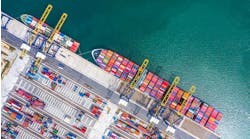Here's some news that came out of ProMat: Companies are expected to invest heavily in supply chain technologies over the next few years. Now, the question is: At which ProMat was that statement made, and in what year? True, it was said at last month's ProMat 2015 show, in an "annual industry report" panel presentation hosted by trade association MHI and consulting firm Deloitte, but I'm pretty sure the same prediction has been made at every ProMat dating back at least to the previous century.
Fact of the matter is, thanks to the loosening definition of what constitutes "supply chain technology," companies are always investing heavily in some sort of technology—at least, the ones that plan to stay in business. Virtually everything on display at ProMat could be considered technology of one kind or another, from batteries to containers to conveyors to labels to lift trucks to motors to packaging equipment to pallets to robots to WMS and everything in between. So it's not really a question of whether companies are investing in technology, but rather a question of, are they investing in the right technology?
"The speed at which supply chain innovation is being adopted—coupled with rising consumer expectations for anytime, anywhere service—is stressing traditional supply chains to near-breaking points," says George Prest, CEO of MHI. "Companies that continue to use traditional supply chain models will struggle to remain competitive and deliver orders that are accurate and on-time."
John Hill, a director at The St. Onge Company and a member of MH&L's editorial advisory board, points out, "Philosophically, nothing has changed in the last 50 years. I've been hearing about 'better-faster-cheaper' for decades. The main difference today is the incredible advancement of technology that's accelerating delivery speeds and consumer expectations."
According to the industry report, there are eight technologies in particular that will be driving next-generation supply chains (listed in order of their adoption rate):
- Inventory and network optimization tools (maturing technology);
- Sensors and automatic ID (maturing);
- Cloud computing and storage (maturing);
- Robotics and automation (maturing);
- Predictive analytics (growth technology);
- Wearable and mobile technology (growth);
- 3-D printing (emerging technology);
- Driverless vehicles and drones (emerging).
Among the maturing technologies, adoption levels are at 35% or higher, and by 2019 it's expected that the adoption rate will reach 80-90%. These technologies are quickly reaching the status of low-hanging fruit, where any company not already using them can enjoy dramatic improvements in efficiency and service. "For instance, inventory and network optimization tools can reduce supply chain costs by 10% or more, with larger potential reduction in total inventory costs," explains Scott Sopher, principal with Deloitte Consulting.
In the category of growth technologies, adoption rates by companies are less than 25%, but the MHI/Deloitte report suggests that predictive analytics could hit 70% by the end of the decade. "Predictive analytics are changing consumer buying behavior, and supply chain professionals need to be able to satisfy the increasing demands of consumers who expect products delivered exactly when promised," observes Bill Abernathy, head of North America product supply logistics excellence with Bayer CropScience.
In terms of hard-to-reach fruit, driverless vehicles and drones—despite plenty of publicity—have yet to catch on in manufacturing and distribution facilities, with adoption rates hovering around 10%. And most of those applications are of technologies that predate the drone hype, such as automated storage and retrieval systems (AS/RS). Even so, if the MHI/Deloitte projections pan out, 20% of logistics organizations could be using drones as soon as 2017 for some of their monitoring, searching and event management activities.
The bottom line when it comes to investing in technology, of course, is to spend tactically and wisely. "You have to be careful that you don't fall prey to the 'new toy' syndrome," Abernathy cautions. "Understand what you need and then seek out the solution that will make your company more profitable."
And don't ever rest on your laurels, or think that you can stand pat with your current situation. "Today is the slowest day of the rest of your life," says Brian Hancock, senior vice president of supply chain at retailer Family Dollar. "Things are only going to get faster."





